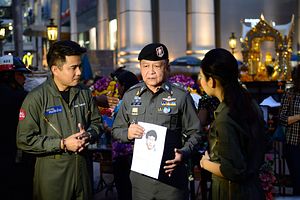More than a month after the deadly bombing at central Bangkok’s Erawan shrine, the Thai authorities have made two arrests in the case, and issued at least seventeen arrest warrants overall. On Monday, the Thai police announced that one of the men in custody was the person caught on closed circuit television on the day of the bombing in August—the man who appeared to be leaving a bomb at the shrine. But some Thai commentators remain doubtful that the government has gotten closer to actually solving the case.
The lack of trust that the Thai authorities have arrested the actual perpetrators stems from several factors. First, in recent years the Thai police and security forces have demonstrated a pattern of problematic investigations of major crimes, whether the 2006 New Year’s Eve bombings in Bangkok, or the 2014 Koh Tao murder case, in which two foreign tourists were killed on the resort island. In the Koh Tao case, the police initially announced that two indigent Burmese migrants, who are now on trial, confessed to the crime, but the two later recanted their confession and claimed that they only confessed after being tortured. They are now standing trial, but there are significant amounts of evidence that call their guilt into question. Most recently, Thailand’s most prominent forensics investigator announced that DNA on the Koh Tao murder weapon does not match the DNA of the accused migrants. According to Time, “The [Koh Tao] prosecution’s case rests on DNA samples found on [one tourist’s] body that investigators say match the defendants. Defense lawyers had asked for the samples to be retested but police said the evidence had been ‘used up.’”
As commentator Saksith Saiyasombut notes, the Thai police also continue to use methods that seem, at the least, outdated. They continue to have people arrested for crimes appear in public to “re-enact” the alleged criminal acts. In early September, Thai police led one of the Erawan suspects, Yusufu Mierili, around central Bangkok, where he went through the steps he supposedly took on the bombing day, with reporters there to cover the re-enactment. Such re-enactments, one would think, would make it more difficult for the alleged criminals to have a fair trial, though what they say at the re-enactment is theoretically not usable in court. In addition, Saksith notes, re-enactments do not further the investigation, and at times they have led to mobs of people attacking the suspect right after the re-enactment.
The Thai police also sometimes receive large, publicly announced, rewards when they apparently make breakthroughs in cases, an unusual practice in law enforcement. In the bombing case, the Thai police already have twice announced that they will be keeping two rewards. The first reward, as the Associated Press reported, was originally “offered to the public for tips leading to the arrest of suspects” but police gave it to themselves. Then, earlier this week Thailand’s police chiefs announced the police were awarding themselves a second reward, essentially for making substantial progress in the investigation. The police chiefs brandished thick stacks of cash for the media earlier this week to demonstrate how much money they were getting.
Third, there have been a range of inconsistencies in the statements of the people arrested, and in the statements of Thai authorities about those arrested and about the reasons for the attack. The Thai government has at times suggested the bombers acted to avenge a crackdown on their human trafficking network, to take revenge for Thailand’s deportation of a group of Uighurs back to China in July, to strike a blow for the insurgents fighting the Thai government in the deep south, or even for reasons related to Thailand’s domestic politics. At various times in the investigation, government officials have said that one of the men in custody, Adem Karadag, was not the man who planted the bomb; now, government officials say he is. The government also has tried to implicate a range of other suspects in the bombing, mostly local opponents of the military regime.
Finally, more than a year in the Thai junta’s rule, the level of popular distrust in the government generally has risen; this distrust carries over to the government’s handling of the bombing case. Opaque policymaking and crackdowns on dissent remain the norm. Earlier this month, prominent journalist Pravit Rojanaphruk, an outspoken critic of military rule, was taken to a Thai army base for an “attitude adjustment” in a tiny cell. After his stay at the army base, he quit his job at The Nation, a prominent Thai paper, apparently under pressure from some of his colleagues.
Joshua Kurlantzick is a fellow for Southeast Asia at the Council on Foreign Relations. This post appears courtesy of CFR.org.

































